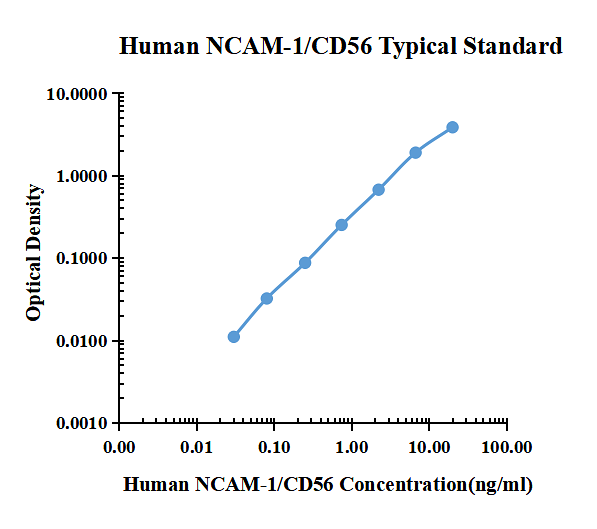Human NCAM 1/CD56 enzyme-linked immunoassay kit
| Specification | 96 Test |
|---|---|
| Sensitivity | 3.69 pg/ml (50 μl);37.5 pg/ml (10 μl) |
| Standard Curve Range | 0.03~20 ng/ml |
| Standard Curve Gradient | 7 Points/3 Folds |
| Number of Incubations | 2 |
| Detectable sample | Liquid phase sample of soluble substances. For example: serum, plasma, cell culture supernatant, tissue grinding liquid, etc. |
| Sample Volume | 50 μl/10 μl |
| Type | Fully Ready-to-Use |
| Operation Duration | 120min |

| ng/ml | O.D. | Average | Corrected | |
|---|---|---|---|---|
| 0.00 | 0.0268 | 0.0287 | 0.0278 | |
| 0.03 | 0.0416 | 0.0360 | 0.0388 | 0.0111 |
| 0.08 | 0.0543 | 0.0660 | 0.0602 | 0.0324 |
| 0.25 | 0.1195 | 0.1114 | 0.1155 | 0.0877 |
| 0.74 | 0.2833 | 0.2774 | 0.2804 | 0.2526 |
| 2.22 | 0.6849 | 0.7219 | 0.7034 | 0.6757 |
| 6.67 | 1.9060 | 1.9530 | 1.9295 | 1.9018 |
| 20.00 | 3.7930 | 3.9828 | 3.8879 | 3.8602 |
Precision
| Intra-assay Precision | Inter-assay Precision | |||||
| Sample Number | S1 | S2 | S3 | S1 | S2 | S3 |
| 22 | 22 | 22 | 6 | 6 | 6 | |
| Average(pg/ml) | 233.5 | 1498.4 | 4930.0 | 366.5 | 1837.9 | 5636.7 |
| Standard Deviation | 18.1 | 103.1 | 326.6 | 10.0 | 52.2 | 150.9 |
| Coefficient of Variation(%) | 7.8 | 6.9 | 6.6 | 2.7 | 2.8 | 2.7 |
Intra-assay Precision (Precision within an assay) Three samples of known concentration were tested twenty times on one plate to assess intra-assay precision.
Inter-assay Precision (Precision between assays) Three samples of known concentration were tested six times on one plate to assess intra-assay precision.
Spike Recovery
The spike recovery was evaluated by spiking 3 levels of human NCAM-1/CD56 into health human serum sample. The un-spiked serum was used as blank in this experiment.
The recovery ranged from 80% to 98% with an overall mean recovery of 88%.
Sample Values
| Sample Matrix | Sample Evaluated | Range (ng/ml) | Detectable (%) | Mean of Detectable (ng/ml) |
|---|---|---|---|---|
| Serum | 30 | 286.3-459.6 | 100 | 370.6 |
Serum/Plasma – Thirty samples from apparently healthy volunteers were evaluated for the presence of NCAM-1/CD56 in this assay. No medical histories were available for the donors.
Product Data Sheet
Background: NCAM 1/CD56
Neural cell adhesion molecule 1 (NCAM-1) is a multifunctional member of the Ig superfamily. It belongs to a family of membrane-bound glycoproteins that are involved in Ca++ independent cell matrix and homophilic or heterophilic cell-cell interactions. NCAM-1 specifically binds to heparan sulfate proteoglycans, the extracellular matrix protein agrin, and several chondroitin sulfate proteoglycans that include neurocan and phosphocan. There are three main forms of human NCAM-1 that arise by alternate splicing. These are designated NCAM-120/NCAM-1 (761 amino acids [aa]), NCAM-140 (848 aa), and NCAM-180 (1120 aa). NCAM-120 is GPI-linked, while NCAM-140 and NCAM-180 are type I transmembrane glycoproteins. Additional alternate splicing adds considerable diversity to all three forms, and extracellular proteolytic processing is possible for NCAM-180. NCAM-1 is synthesized as a 761 aa preproprecursor that contains a 19 aa signal sequence, a 722 aa GPI-linked mature region, and a 20 aa C-terminal prosegment. The molecule contains five C-2 type Ig-like domains and two fibronectin type-III domains. Human to mouse, NCAM-1 is 93% aa identical. NCAM-1 appears to be highly sialylated. The polysialyation of NCAM-1 reduces its adhesive property and increases its neurite outgrowth promoting features. NCAM-1 in the adult brain shows a decline of sialylation relative to earlier developmental periods. In regions that retain a high degree of neuronal plasticity, however, the adult brain continues to express polysialylation-NCAM-1, suggesting sialylation of NCAM-1 is involved in regenerative processes and synaptic plasticity.

